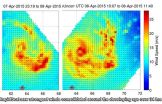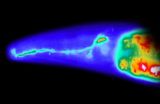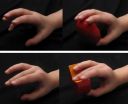NASA sees Tropical Cyclone Joalane's winds consolidate around its eye
2015-04-09
(Press-News.org) The RapidScat instrument that flies aboard the International Space Station (ISS) provided data about Tropical Cyclone Joalane's surface winds that showed how the strongest sustained winds consolidated as the tropical cyclone intensified and developed an eye. As of April 9, warnings were in effect at Rodrigues Island in the Southern Indian Ocean as Joalane approached.
RapidScat measured the surface winds within Tropical Cyclone Joalane late on April 7 and on April 8, revealing that the strongest winds consolidated over a 24 hour period. RapidScat measured Joalane's winds on April 7 from 23:19 to 00:52 (7:19 p.m. to 8:52 p.m. EDT) and April 8 from 10:07 to 11:40 UTC (6:07 p.m. to 11:40 p.m. EDT).
The strongest sustained winds up reached up to 30 meters per second (67.1 mph/108 kph). During the earlier pass on April 7, those strongest wind speeds were north and east of the developing eye, and extending south and east in a wide band of thunderstorms. On April 8, the strongest surface winds became more concentrated and circled the entire center (which was an eye at that time). Sustained winds of 30 meters per second (67.1 mph/108 kph) were also seen in occurring bands of thunderstorms south and east of the center. The data was generated into images at NASA's Jet Propulsion Laboratory in Pasadena, California.
On April 9 at 05:50 UTC (1:50 a.m. EDT), the Moderate Resolution Imaging Spectroradiometer or MODIS instrument aboard NASA's Aqua Satellite captured visible-light data of Tropical Cyclone Joalane. That data was made into an image by the MODIS Rapid Response Team at NASA's Goddard Space Flight Center in Greenbelt, Maryland. The image showed banding of thunderstorms in the southwestern and northeastern quadrants of the storm, wrapping into the storm's center. The eye of the storm now just 7 nautical miles (8.0 miles/12.9 km) wide according to microwave data was obscured by clouds in the visible MODIS imagery.
A Class I tropical cyclone warning was posted on April 9 at Rodrigues. For updated forecasts for Rodrigues Island, visit the Mauritius Meteorological Services website at: http://metservice.intnet.mu/.
By 1500 UTC (11 a.m. EDT), Joalane's maximum sustained winds were still at 80 knots (92 mph/148.2 kph), just where they were 24 hours before. Joalane is still a strong Category 1 hurricane on the Saffir-Simpson hurricane wind scale. Joalane's center was near 17.0 south latitude and 65.7 east longitude, about 513 nautical miles (590.3 miles/ 950.1 km) east-northeast of Port Louis, Mauritius. As it was 24 hours before, Joalane was still moving at 6 knots (6.9 mph/11.1 kph) but shifted its path from the south-southeast to due south.
Joalane is moving south into an area of cooler sea surface temperatures and increased vertical wind shear. It is expected to start weakening in a day while transitioning into an extra-tropical storm.
INFORMATION:
[Attachments] See images for this press release:


ELSE PRESS RELEASES FROM THIS DATE:
2015-04-09
Outbreaks of leukemia that have devastated some populations of soft-shell clams along the east coast of North America for decades can be explained by the spread of cancerous tumor cells from one clam to another. Researchers call the discovery, reported in the Cell Press journal Cell on April 9, 2015, "beyond surprising."
"The evidence indicates that the tumor cells themselves are contagious--that the cells can spread from one animal to another in the ocean," said Stephen Goff of the Howard Hughes Medical Institute and Columbia University. "We know this must be true because ...
2015-04-09
Autism spectrum disorder (ASD) can produce strikingly different clinical outcomes in young children, with some having strong conversation abilities and others not talking at all. A study published by Cell Press April 9th in Neuron reveals the reason: At the very first signs of possible autism in infants and toddlers, neural activity in language-sensitive brain regions is already similar to normal in those ASD toddlers who eventually go on to develop good language ability but nearly absent in those who later have a poor language outcome.
"Why some toddlers with ASD get ...
2015-04-09
Using induced pluripotent stem cells (iPSCs), a team led by Mount Sinai researchers has gained new insight into genetic changes that may turn a well known anti-cancer signaling gene into a driver of risk for bone cancers, where the survival rate has not improved in 40 years despite treatment advances.
The study results, published today in the journal Cell, revolve around iPSCs, which since their 2006 discovery have enabled researchers to coax mature (fully differentiated) bodily cells (e.g. skin cells) to become like embryonic stem cells. Such cells are pluripotent, able ...
2015-04-09
LA JOLLA--If you had 10 chances to roll a die, would you rather be guaranteed to receive $5 for every roll ($50 total) or take the risk of winning $100 if you only roll a six?
Most animals, from roundworms to humans, prefer the more predictable situation when it comes to securing resources for survival, such as food. Now, Salk scientists have discovered the basis for how animals balance learning and risk-taking behavior to get to a more predictable environment. The research reveals new details on the function of two chemical signals critical to human behavior: dopamine--responsible ...
2015-04-09
A genetic mutation associated with an increased risk of developing eating disorders in humans has now been found to cause several behavioral abnormalities in mice that are similar to those seen in people with anorexia nervosa. The findings, published online April 9 in Cell Reports, may point to novel treatments to reverse behavioral problems associated with disordered eating.
"It's been known for a long time that about 50% to 70% of the risk of getting an eating disorder was inherited, but the identity of the genes that mediate this risk is unknown," explains senior author ...
2015-04-09
Two types of touch information -- the feel of an object and the position of an animal's limb -- have long been thought to flow into the brain via different channels and be integrated in sophisticated processing regions. Now, with help from a specially devised mechanical exoskeleton that positioned monkeys' hands in different postures, Johns Hopkins researchers have challenged that view. In a paper published in the April 22 issue of Neuron, they present evidence that the two types of information are integrated as soon as they reach the brain by sense-processing brain cells ...
2015-04-09
It turns out sea turtles, even at a tender 6-18 months of age, are very active swimmers. They don't just passively drift in ocean currents as researchers once thought. NOAA and University of Central Florida researchers say it's an important new clue in the sea turtle "lost years" mystery. Where exactly turtles travel in their first years of life, before returning to coastal areas as adults to forage and reproduce, has puzzled scientists for decades.
"All species of sea turtles are endangered or threatened under the Endangered Species Act; knowing their distribution is ...
2015-04-09
Building on their discovery of a gene linked to eating disorders in humans, a team of researchers at the University of Iowa has now shown that loss of the gene in mice leads to several behavioral abnormalities that resemble behaviors seen in people with anorexia nervosa.
The team, led by Michael Lutter, MD, PhD, assistant professor of psychiatry in the UI Carver College of Medicine, found that mice that lack the estrogen-related receptor alpha (ESRRA) gene are less motivated to seek out high-fat food when they are hungry and have abnormal social interactions. The effect ...
2015-04-09
WASHINGTON -- Facial plastic surgery may do more than make you look youthful. It could change -- for the better -- how people perceive you. The first study of its kind to examine perception after plastic surgery finds that women who have certain procedures are perceived as having greater social skills and are more likeable, attractive and feminine.
The study is not superficial -- the importance of facial appearance is rooted in evolution and studies suggest that judging a person based on his or her appearance boils down to survival. The results were published online ...
2015-04-09
Facial rejuvenation surgery may not only make you look younger, it may improve perceptions of you with regard to likeability, social skills, attractiveness and femininity, according to a report published online by JAMA Facial Plastic Surgery.
The relationship between facial features and personality traits has been studied in other science fields, but it is lacking in the surgical literature, according to the study background.
Michael J. Reilly, M.D., of the MedStar Georgetown University Hospital, Washington, and coauthors measured the changes in personality perception ...
LAST 30 PRESS RELEASES:
[Press-News.org] NASA sees Tropical Cyclone Joalane's winds consolidate around its eye






